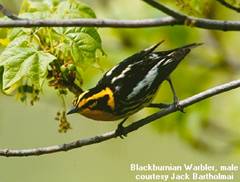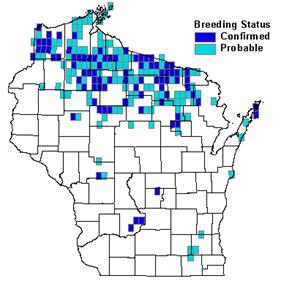Photo by Jack Bartholmai


Status/Protection
- Global Rank: G5 Key to global and state ranks
- State Rank: S3S4B, SZN
- WBCI Priority: PIF
Population Information
Federal BBS information can be obtained at http://www.mbr-pwrc.usgs.gov/bbs/bbs.html by clicking on Trend Estimates and selecting the species in question. All estimates are for 1966-2005.
- Federal Breeding Bird Survey: non-significant increase
- Federal Breeding Bird Survey (WI): non-significant increase
- Federal Breeding Bird Survey (BCR 23): non-significant decline
- Federal Breeding Bird Survey (BCR 12): non-significant increase
- Chequamegon National Forest Bird Survey (NRRI): significant increase (1992-2005)
- WSO Checklist Project: stable (1983-2007)
Life History
- Breeding Range: Saskatchewan east across southern Canada and the northeastern U.S. to Atlantic Coast, extending south into Appalachian Mountains (Morse 2004).
- Breeding Habitat: White Pine, Fir-Spruce, Hemlock Hardwood, Black Spruce, Swamp Conifer-Balsam Fir, Red Pine, mature coniferous and mixed coniferous-deciduous forest stands.
- Nest: Cup, usually at least 10 meters above ground (Ehrlich et al. 1988, Morse 2004).
- Nesting Dates: Eggs: early June to early July (WSO 1995).
- Foraging: Foliage glean, hover glean, hawks, bark glean (Ehrlich et al. 1988).
- Migrant Status: Neotropical migrant.
- Habitat use during Migration: All forest types, forest edge, scrub, thickets (Morse 2004).
- Arrival Dates: Early May to early June (Robbins 1991).
- Departure Dates: Early August to early October (Robbins 1991).
- Winter Range: Bolivia, Columbia, Ecuador, Peru, Venezuela, some in s. Central America (DeGraaf and Rappole 1995).
- Winter Habitat: Canopy of forests in Central and South America, rain forest, cloud forest, plantations (Morse 2004).
Habitat Selection
The Blackburnian Warbler inhabits mature coniferous and mixed deciduous/coniferous forests dominated by eastern hemlock, white pine, balsam fir, and spruce (Robbins 1991, Harriman 2006). In managed forests, this species generally prefers stands older than rotation age (Doepker et al. 1992, Cumming and Diamond 2002). In Wisconsin the Blackburnian Warbler nests in the northern-most counties containing northern mesic forest (Hoffman 1989), boreal forest, and northern pine forest habitats (Hoffman and Mossman 1990). It often selects white pines for nesting (Beals 1960). It also breeds in the Baraboo Hills in small numbers and in the pine relicts of Baxter’s Hollow, Hemlock Draw, Pine Hollow, and Pine Glen (Mossman and Lange 1982). Nests are built on the outer portion of branches, usually 3 meters from the trunk and 1.5 - 25 meters above ground (average height 10 m). Blackburnian Warblers forage in the high branches of conifers by hovering at small branches and working radially within a single tree. Both their location and method of foraging allows them to coexist with other Dendroica warblers foraging in the same forest and often in the same coniferous trees (Morse 2004).
Habitat Availability
Prior to Euro-American settlement, the northern mesic forest covered the largest acreage of any Wisconsin vegetation type. Although this forest type is still very extensive, current forest conditions may not be suitable for Blackburnian Warblers. Many mature and old-growth stands have been replaced by second-growth forests of aspen, white birch, sugar maple, and red maple (WDNR 2005). The significant reduction of hemlocks within many of these forest stands likely lessens their habitat suitability. The loss of boreal and white pine forests has also reduced the amount of quality habitat available. Boreal forest habitat in Wisconsin has experienced significant loss within the past century, as little as 1% remains in presettlement condition (Mossman et al. 1990). Wisconsin also has lost approximately 12% of its northern pine forest habitat in the past century (Snetsinger and Ventura, n.d.).
Population Concerns
Breeding Bird Survey data suggest an increasing population trend both range-wide and within Wisconsin, but neither trend is statistically significant (Sauer et al. 2005). Blackburnian Warblers remain a relatively common breeder in the northern region of the state. During the six-year period (1995-2000) of the Wisconsin Breeding Bird Atlas, observers documented Blackburnian Warblers in 22% of the quads with breeding confirmed in approximately 7% (Harriman 2006). Although the Blackburnian Warbler population remains relatively stable within the state, forest harvesting practices that fail to maintain mature stands may have serious implications to its future. Other threats to this species include forest fragmentation and deforestation on the tropical wintering grounds (Morse 2004).
Recommended Management
Management for this species should focus on protecting mature and old-growth stands of conifers, especially those dominated by hemlock and white pine. Older age classes are currently underrepresented in many of Wisconsin’s heavily-managed forests (WDNR 2005). The simplified composition and structure of vegetation typical of intensively managed, even-age monocultures will not provide suitable habitat for this species (Doepker et al. 1992). Forest management practices that encourage development of old-growth characteristics such as large trees, diverse tree species composition, and structural heterogeneity will benefit Blackburnian Warblers. Lengthening harvest schedules to maintain stands >120 years old will likely benefit this species (Cumming and Diamond 2002). Reducing forest fragmentation by increasing forest patch size, increasing the proportion of interior to edge, retaining large conifers, especially hemlock, white pine, and white spruce, and avoiding the placement of clearcuts in the immediate vicinity of stands with high conservation value or restoration potential also is warranted (WDNR 2005). For managed mesic forests that lack a coniferous component, managers should consider underplanting conifer species.
Research Needs
More information is needed regarding the ecology of this species on its wintering grounds (Morse 2004). Blackburnian Warblers are part of an ecological community that occurs in relatively undisturbed forests (Askins 2000). Thus, additional research is needed on the impacts of natural disturbances (e.g., fire, windstorms) on this species and its associates. More research is needed about the basic breeding biology of this species - its propensity to nest high in conifers makes it difficult to ascertain incubation dates, fledging time, and other aspects of the nesting cycle (Morse 2004). In Wisconsin, more information on minimum patch size requirements would help guide future management efforts.
Information Sources
- Chequamegon National Forest Bird Survey (NRRI) species account: http://www.nrri.umn.edu/mnbirds/accounts/BLBWa2.htm
- Great Lakes Bird Conservation probability map http://www.uwgb.edu/birds/greatlakes/species/blbwmap2.htm
- Nicolet NF bird survey species map http://www.uwgb.edu/birds/nnf/species/BLBW.htm
- Nicolet NF bird survey habitat/species group map http://www.uwgb.edu/birds/nnf/mucfbirds.htm
- North American Breeding Bird Survey: http://www.npwrc.usgs.gov
- Temple S.A., J.R. Cary, and R. Rolley. 1997. Wisconsin Birds: A Seasonal and Geographical Guide. Wisconsin Society of Ornithology and Wisconsin Department of Natural Resources, Madison, WI.
- Wisconsin Breeding Bird Atlas: http://www.uwgb.edu/birds/wbba/
References
- Askins, R.A. 2000. Restoring North America’s birds: lessons from landscape ecology. Yale Univ. Press, New Haven, CN.
- Beals, E. 1960. Forest bird communities in the Apostle Islands of Wisconsin. Wilson Bulletin 72: 156–181.
- Cumming, E.E, A.W. Diamond. 2002. Songbird community composition versus forest rotation age in Saskatchewan boreal mixed-wood forest. Canadian Field-Naturalist 116: 69-75.
- DeGraaf, R.M. and J.H. Rappole. 1995. Neotropical migratory birds: natural history, distribution, and population change. Comstock Publ. Assoc., Cornell Univ. Press, Ithaca, NY.
- Doepker, R.V., R.D. Earle, J.J. Ozoga. 1992. Characteristics of Blackburnian Warbler, Dendroica fusca, breeding habitat in upper Michigan. Canadian Field-Naturalist 106: 366–371.
- Ehrlich, P.R., D.S. Dobkin, and D. Wheye. 1988. The birders handbook: a field guide to the natural history of North American birds. Simon & Schuster, Inc. New York.
- Harriman, B.R. 2006. Blackburnian Warbler. In Atlas of the Breeding Birds of Wisconsin. (N.J. Cutright, B.R. Harriman, and R.W. Howe, eds.) The Wisconsin Society for Ornithology, Inc. 602pp.
- Hoffman. R.M. 1989. Birds of Wisconsin northern mesic forests. Pass. Pigeon 51(1): 97-110.
- Hoffman, R.M. and M.J. Mossman, 1990. Birds of northern Wisconsin pine forests. Pass. Pigeon 52(4): 339-356.
- Morse, D.H. 2004. Blackburnian Warbler (Dendroica fusca). The Birds of North America Online. (A. Poole, Ed.) Ithaca: Cornell Laboratory of Ornithology; Retrieved from The Birds of North American Online database: http://bna.birds.cornell.edu/BNA/account/Blackburnian_Warbler/.
- Mossman, M.J. and K.I. Lange. 1982. Breeding Birds of the Baraboo Hills, Wisconsin: Their History, Distribution, and Ecology. WI Department of Natural Resources, and WI Society for Ornithology, Madison.
- Mossman, M.J., E. Epstein, and R.M. Hoffman. 1990. Birds of Wisconsin boreal forests. Pass. Pigeon 52(2): 153-168.
- Robbins, S.D. 1991. Wisconsin birdlife: population & distribution, past & present. Univ. of Wisconsin Press, Madison, WI.
- Sauer, J.R., J.E. Hines, and J. Fallon. 2005. The North American Breeding Bird Survey, Results and Analysis 1966 - 2005. Version 6.2.2006. USGS Patuxent Wildlife ResearchCenter, Laurel, MD.
- Snetsinger, S. and S. Ventura. n.d. Landcover change in the Great Lakes region from mid-nineteenth century to present. Online at http://www.ncrs.fs.fed.us/gla/
- Wisconsin Department of Natural Resources (WDNR). 2005. Wisconsin’s Strategy for Wildlife Species of Greatest Conservation Need. Madison, WI.
- Wisconsin Society for Ornithology (WSO). 1995. Wisconsin breeding bird atlas: atlasing handbook 1995-1999. Wisconsin Society for Ornithology, Inc., Hartland, WI.
Contact Information
- Compiler: William P. Mueller, iltlawas@earthlink.net
- Editors: Kim Kreitinger, K.Kreitinger@gmail.com |
Jim Baughman, James.Baughman@Wisconsin.gov
